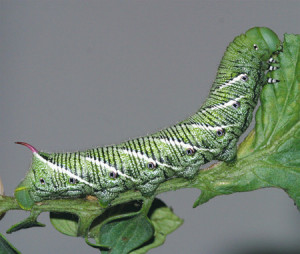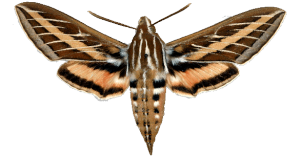
The tobacco hornworm, Manduca sexta, is a common pest on tomatoes as well as tobacco. The tobacco hornworm is distinguished from the tomato hornworm by its red, pink or orangish horn.
Hornworm caterpillars belong to the moth family Sphingidae. They are so named because of the horn-like projection at the end of the eighth (last) abdominal segment. Hornworms are notable for both their horns and the uncommonly large size of many of the species. The larva of the giant sphinx may exceed six inches in length. Some, like the tomato and tobacco hornworms, are common pests of vegetable gardens. Others spend their lives in obscurity on little noticed wild plants, most likely to be spotted as adults.
Hornworm caterpillars turn into sphinx or hawk moths, a remarkable group of moths that often fly during both day and nighttime hours. With their sharp wings and hovering flight, hawk moths are frequently mistaken for small hummingbirds. Adult moths lay their large, spherical eggs on the undersides of leaves. The caterpillars that hatch feed on leaves, often causing considerable damage. One of the best ways to spot hornworm caterpillars is to look for their rather large droppings.
